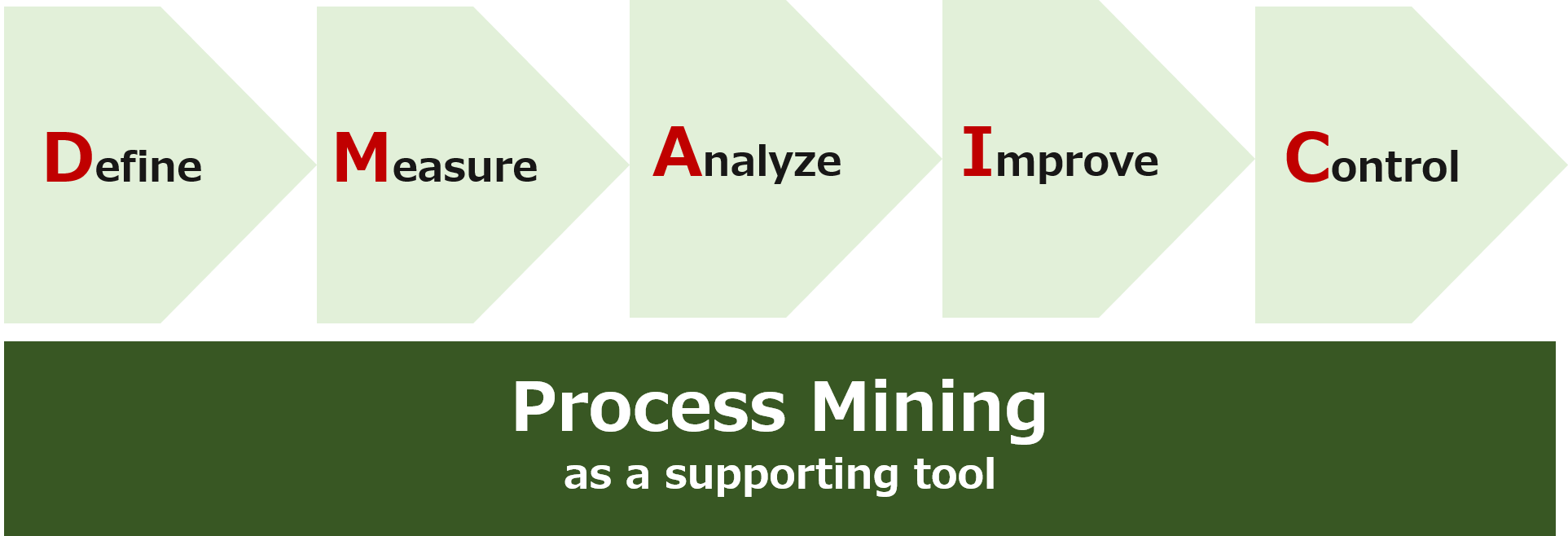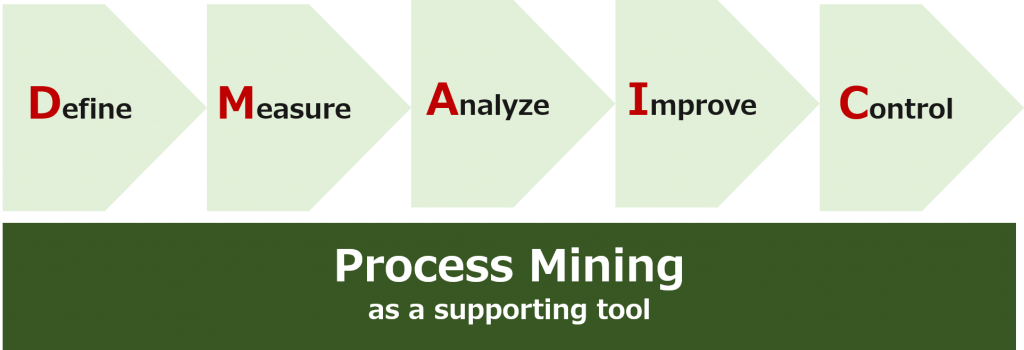Six Sigma approach should be used with process mining
English follows Japanese. Before proofread.
率直に言えば、プロセスマイニングは、現状の業務を把握するための業務分析のひとつに過ぎません。
もちろん、従来の現場担当者へのヒアリングや観察調査よりもはるかに正確に、かつ効率的に業務分析を行うことができるのがプロセスマイニングであり、だからこそ近年、急速に注目が高まっています。
企業・組織においてプロセスマイニングが活用される場面は、多くはBPR(Business Process Re-engineering)、あるいは業務プロセス改善(Business Process Improvement)の取り組みであり、プロジェクトでしょう。
したがって、分析手法としてのプロセスマイニングの手順を理解しておくだけでなく、BPR、あるいは業務プロセス改善の手順やフレームワークを理解し、活用することが重要です。
BPR、業務プロセス改善のアプローチに様々なものがありますが、シックスシグマの方法論を土台として採用するのがベストと考えます。
シックスシグマは、トヨタ生産システムの考え方を元に、モトローラが開発した業務プロセス改善手法です。つまり、日本で生まれたフレームワークが多く含まれています。
さて、シックスシグマにおける業務プロセス改善プロジェクトの進め方は「DMAIC」として知られています。以下の5つの活動フェーズの頭文字を取ったものです。
- Define(定義)
- Measure(測定)
- Analyze(分析)
- Improve(改善)
- Control(定着・管理)
それぞれの活動フェーズとプロセスマイニングの関係について簡単に説明します。
Define(定義)
まず、改善した対象のプロセス、また想定される問題・課題を明確化します。基本的には、残業多く従業員が疲弊している、納期遅れなどで顧客からのクレームが増えているなど、現象として把握できる問題を起点として、それがどのプロセスのどこに問題がありそうかの当たりをつけて、改善対象としていきます。
ここは、プロセスマイニングプロジェクトの「スコーピング」、すなわち「分析計画立案」の前提となるフェーズです。
Measure(測定)
現状を把握するために必要なデータ・情報を集めます。前述したように、従来は、現場担当者へのヒアリング、観察調査、また関係者を一同に集めたワークショップを開催して、現行業務プロセスの棚卸しを行うのが定番です。
プロセスマイニングでは、上記のような情報収集方法に加えて、ITシステム上での業務遂行履歴データである「イベントログ」を抽出し、分析対象とします。
プロセスマイニングから得られたプロセスモデル(as isプロセス)は、事実ベースの正確な業務プロセスの再現を可能としますが、システム以外で行われている業務は当然ながら把握できませんので、ヒアリングや観察調査による補完が不可欠です。
Analyze(分析)
前フェーズで得られた情報・データに基づき様々な視点で分析を遂行します。
プロセスマイニングを採用したプロジェクトでは、まずイベントログからのプロセスモデルを元に、業務遂行に時間がかかりすぎている、非効率な箇所や、業務の滞留が発生しているボトルネックを容易に発見できるため、そうした現象としての問題が特定できた箇所について、ヒアリングや現場調査の分析を掘り下げることが可能となります。
プロセスマイニングを採用しない場合、現場ヒアリングは「なにをどのようにやっていますか(What、How)」という問いから始めなければなりませんが、プロセスモデルを見ながらであれば、「なぜこうなるのでしょうか(Why)」の問いが行えるので根本原因の追求が行いやすいと言えます。
Improve(改善)
現象として見える問題・課題(非効率性やボトルネック等)の根本原因が解明できたら、具体的な改善施策を練り、改善活動を行うことになります。実行段階ですから、プロセスマイニングはいったん舞台袖に引っ込むことになりますが、次のControl(定着・管理)に備えて、着々とイベントログは蓄積されています。
Control(定着・管理)
最後は、改善された業務プロセスの定着と管理です。以前より優れた業務プロセスを開発でき、現場に展開したとしても、そのままほおっておくと、再び旧来のやり方に戻ってしまう、ということが起こりえます。
したがって、新しいプロセスが定着するよう、継続的な監視と適切な指導が必要です。ここで、プロセスマイニングを活用すれば、ITシステム上で日々遂行される操作履歴データをリアルタイムで抽出・分析し、現在遂行中の案件についての逸脱や問題個所をすばやく発見、アラートを出すことが可能となりますので、新業務プロセスの確実な定着を促進できるのです。
Frankly, process mining is just a business analysis to get a handle on what’s going on.
Of course, process mining is able to conduct business analysis much more accurately and efficiently than conventional interviews and observational surveys with field staff, and for this reason, it has rapidly gained attention in recent years.
In many cases, process mining is used in BPR(business process re-engineering) or business process improvement projects.
Therefore, it is important not only to understand the procedure of process mining as an analytical method, but also to understand and utilize the procedure and framework of BPR or business process improvement.
There are various approaches to BPR and business process improvement, but I think it is best to adopt Six Sigma’s methodology as a foundation.
Six Sigma is a business process improvement method developed by Motorola based on the Toyota Production System concept. That is, it includes many frameworks that originated in Japan.
The process improvement project at Six Sigma is known as the “DMAIC”. It is an acronym for the following five phases of activity.
- Define
- Measure
- Analyze
- Improve
- Control
A brief description of the relationship between each activity phase and process mining.
Define
First, identify the processes that need to be improved, as well as potential problems and issues. Basically, problems that can be identified as phenomena, such as excessive overtime and exhausted employees, or an increase in customer complaints due to delivery delays, are identified and identified as problems in which processes are likely to have problems, and are targeted for improvement.
This is the prerequisite phase of the process mining project “scoping” or “analysis planning”.
Measure
Collect the data and information needed to understand the current situation. As mentioned earlier, it has traditionally been customary to hold interviews with field staff, conduct observation surveys, and hold workshops with all concerned parties to take inventory of current business processes.
In process mining, in addition to the information gathering methods described above, “Event Log”, which is historical data of business performance on IT systems, is extracted and analyzed.
The process model (as is Process) obtained from process mining enables accurate reproduction of fact-based business processes. However, it is of course impossible to grasp the operations that are being conducted outside of the system. Therefore, complementation through interviews and observational surveys is essential.
Analyze
We conduct analysis from various perspectives based on information and data obtained in the previous phase.
In the case of a project using process mining, based on a process model derived from an event log, it is possible to easily find bottlenecks where work is taking too long, inefficient, or stagnating, so that it is possible to delve into the analysis of interviews and field investigations where such problems have been identified.
If process mining is not adopted, field interviews must begin with the question, “What are you doing and how are you doing it? (What, How)” However, if you look at the process model, you can ask the question, “Why does this happen? (Why)” making it easier to pursue the root cause.
Improve
Once the root causes of problems and issues that appear to be phenomena (Inefficiency, bottlenecks, etc.) have been clarified, specific improvement measures will be formulated and improvement activities will be carried out. Since it is the execution stage, the process mining is retracted to the stage, but the event log is steadily accumulated for the next Control (establishment and management).
Control
The last is to establish and manage improved business processes. You can develop better business processes and deploy them in the field, but if you leave them as they are, you can go back to the old ways.
Therefore, continuous monitoring and appropriate guidance are needed to ensure that new processes take root. By utilizing process mining, it is possible to extract and analyze in real time operation history data that is executed on an IT system on a daily basis, and to quickly find deviations and problem points in an ongoing project and issue alerts, thereby ensuring that new business processes are implemented.


